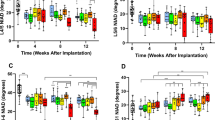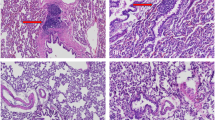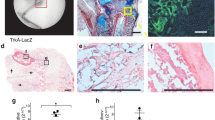Abstract
This study evaluated the ability of gene transfer to enhance bone healing. Segmental defects were created surgically in the femora of New Zealand white rabbits. First generation adenoviruses were used as vectors to introduce into the defects genes encoding either human bone morphogenetic protein-2 (BMP-2) or, as a negative control, firefly luciferase. Representative specimens were evaluated histologically after 8 weeks. Healing of the defects was monitored radiographically for 12 weeks, after which time the repair tissue was evaluated biomechanically. By radiological criteria, animals receiving the BMP-2 gene had healed their osseous lesions after 7 weeks, whereas those receiving the luciferase gene had not. Histologic examination of representative rabbits at 8 weeks confirmed ossification across the entire defect in response to the BMP-2 gene, whereas the control defect was predominantly fibrotic and sparsely ossified. At the end of the 12-week experiment, the control femora still showed no radiological signs of stable healing. The difference in radiologically defined healing between the experimental and control groups was statistically significant (P < 0.002). biomechanical testing of the femora at 12 weeks demonstrated statistically significant increases in the mean bending strength (p < 0.005) and bending stiffness (p < 0.05) of the animals treated with the bmp-2 gene. direct, local adenoviral delivery of an osteogenic gene thus led to the healing of an osseous lesion that otherwise would not do so. these promising data encourage the further development of genetic approaches to enhancing bone healing.
This is a preview of subscription content, access via your institution
Access options
Subscribe to this journal
Receive 12 print issues and online access
$259.00 per year
only $21.58 per issue
Buy this article
- Purchase on Springer Link
- Instant access to full article PDF
Prices may be subject to local taxes which are calculated during checkout




Similar content being viewed by others
References
Albertson KS, Medoff RJ, Mitsumaga MM . The use of periosteally vascularized autografts to augment the fixation of large segmental allografts Clin Orthop Rel Res 1991 269: 113–119
Zaslav KR, Meinhard BP . Management of resistant pseudarthrosis of long bones Clin Orthop Rel Res 1988 233: 234–242
Bostrom M et al. Use of BMP-2 in the rabbit ulnar nonunion model Clin Orthop Rel Res 1996 327: 272–282
Moroni A, Rollo G, Guzzardella M, Zinghi G . Surgical treatment of isolated forearm non-union with segmental bone loss Injury 1997 28: 497–504
Südkamp NP et al. Incidence of non-unions in open fractures: analysis of 948 open fractures Akt Traumatol 1993 23: 59–67
Gerhart TN et al. Healing segmental femoral defects in sheep using recombinant human one morphogenetic protein Clin Orthop Rel Res 1993 293: 317–326
Einhorn TA . Enhancement of fracture healing J Bone Joint Surg 1995 77A: 940–955
Ripamonti U et al. Recombinant transforming growth factor-β1 induces endochondral bone in the baboon and synergizes with recombinant osteogenic protein-1 (bone morphogenetic protein-7) to initiate rapid bone formation J Bone Min Res 1997 12: 1584–1595
Yasko AW et al. The healing of segmental bone defects, induced by recombinant human bone morphogenetic protein (rhBMP) J Bone Joint Surg 1992 74-A: 659–670
Sampath TK et al. TGF-β superfamily proteins induce endochondral bone formation in mammals Proc Natl Acad Sci USA 1993 84: 7109–7113
Hammonds RG et al. Bone inducing activity of mature BMP-2b produced from a hybrid BMP-2 a/b percusor Mol Endocrinol 1991 5: 149–155
Evans CH, Robbins PD . Possible orthopaedic applications of gene therapy J Bone Joint Surg 1995 77-A: 1103–1114
Niyibizi C et al. Potential role for gene therapy in the enhancement of fracture healing Clin Orthop Rel Res 1998 355S: 148–153
Lieberman JR et al. Regional gene therapy with a BMP-2 producing murine stromal cell line induces heterotopic and orthotopic bone formation in rodents J Orthop Res 1998 16: 330–339
Lieberman JR et al. The effect of regional gene therapy with bone morphogenetic protein-2 producing bone-marrow cells on the repair of segmental femoral defects in rats J Bone Joint Surg 1999 81A: 905–917
Fang J et al. Stimulation of new bone formation by direct transfer of osteogenic plasmid genes Proc Natl Acad Sci USA 1996 93: 5753–5758
Bonadio J, Smiley E, Patil P, Goldstein S . Localized direct plasmid gene delivery in vivo: prolonged therapy results in reproducible tissue regeneration Nature Med 1999 5: 753–759
Boden SD et al. Lumbar spine fusion by local gene therapy with a cDNA encoding a novel osteoinductive protein (LMP-1) Spine 1998 23: 2486–2492
Alden TD et al. In vivo endochondral bone formation using a bone morphogenetic protein 2 adenoviral vector Hum Gene Ther 1999 10: 2245–2253
Musgrave DS et al. Adenovirus-mediated direct gene therapy with bone morphogenetic protein-2 produces bone Bone 1999 24: 541–547
Baltzer AWA et al. A gene therapy approach to accelerating bone healing: evaluation of gene expression in a New Zealand white rabbit model Knee Surg Sports Traum Arthrosc 1999 7: 197–200
Mason JM et al. Expression of human bone morphogenetic protein 7 in primary rabbit periosteal cells: potential utility in gene therapy for osteochondral repair Gene Therapy 1998 5: 275–282
Wang EA . Bone morphogenetic proteins (BMPs): therapeutic potential in healing bony defects Trends Biotechnol 1993 11: 379–383
Aspenberg P, Wang E, Thorgren KG . Bone morphogenetic protein induces bone in the squirrel monkey, but bone matrix does not Acta Orthop Scand 1992 63: 619–622
Lind M, Eriksen EF, Bünger C . Bone morphogenetic protein-2 but not bone morphogenetic protein-4 and -6 stimulates chemotactic migration of human osteoblasts, human marrow osteoblasts, and U2-OS cells Bone 1996 18: 53–57
Yamaguchi A et al. Recombinant human BMP-2 stimulates osteoblastic maturation and inhibits myogenic differentiation in vitro J Cell Biol 1991 113: 681–687
Katagiri T et al. BMP-2 converts the differentiation pathway of C2C12 myoblasts into the osteoblast lineage J Cell Biol 1993 6: 1755–1766
Hardy S et al. Construction of adenovirus vectors through Cre-Lox recombination J Virol 1997 71: 1842–1849
Balk ML et al. Effect of rhBMP-2 on the osteogenic potential of bone marrow stromal cells from an osteogenesis imperfecta mouse (oim) Bone 1997 21: 7–15
Acknowledgements
The authors thank Eric Lechmann, Mr Ringler and Mrs Weber for technical support, Holger Haak for contributing statistical expertise, and Christopher Niyibizi PhD for the stromal cell line as well as advice concerning the alkaline phosphatase assays. We are also grateful to Synthes/Colorado for providing the DCP-plates and screws and to Genetics Institute for providing the BMP-2 cDNA.
Author information
Authors and Affiliations
Rights and permissions
About this article
Cite this article
Baltzer, A., Lattermann, C., Whalen, J. et al. Genetic enhancement of fracture repair: healing of an experimental segmental defect by adenoviral transfer of the BMP-2 gene. Gene Ther 7, 734–739 (2000). https://doi.org/10.1038/sj.gt.3301166
Received:
Accepted:
Published:
Issue Date:
DOI: https://doi.org/10.1038/sj.gt.3301166
Keywords
This article is cited by
-
Current Trends in Viral Gene Therapy for Human Orthopaedic Regenerative Medicine
Tissue Engineering and Regenerative Medicine (2019)
-
Biomaterial-mediated strategies targeting vascularization for bone repair
Drug Delivery and Translational Research (2016)
-
The role of transduced bone marrow cells overexpressing BMP-2 in healing critical-sized defects in a mouse femur
Gene Therapy (2015)
-
Osteonecrosis of the femoral head: treatment with ancillary growth factors
Current Reviews in Musculoskeletal Medicine (2015)
-
Hydroxyapatite and demineralized calf fetal growth plate effects on bone healing in rabbit model
Journal of Orthopaedics and Traumatology (2015)



